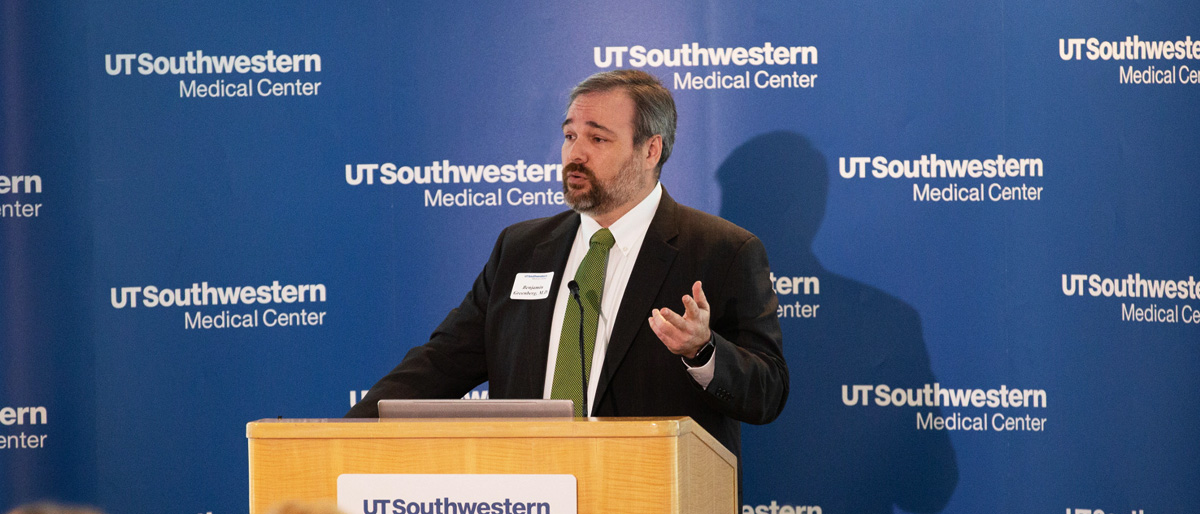'Et tu Brute?' Neurologist takes Shakespearean approach to explain autoimmune disorders

As one of the world’s leading experts on rare autoimmune diseases, Dr. Benjamin Greenberg knows the intricacies of the nervous system and the complex web of terms that defines its components.
Yet, when describing autoimmune disease to lay folk, he kindly offers explanations that are more Shakespearean than scientific.

In a recent lecture he titled “Et tu, Brute?” Dr. Greenberg described the molecular “Brutus” that attacks healthy cells and causes rare conditions such as transverse myelitis or more common ones like multiple sclerosis.
The autoimmune system is supposed to be your friend; it is supposed to protect you from harmful viruses and bacteria,
Dr. Greenberg said March 21 at the Carolyn P. Horchow Women’s Health Symposium. And when it gets confused and commits murder of one of its own, it is an act of betrayal akin to Brutus and Julius Caesar.
Dr. Greenberg, Associate Professor of Neurology and Neurotherapeutics and Pediatrics, a Distinguished Teaching Professor, and Director of the Perot Family Foundation Neurosciences Translational Research Center, presented the latest developments in his field at the annual campus event. The Symposium featured lectures from several Peter O’Donnell Jr. Brain Institute specialists.
He described how autoimmune diseases can manifest in a variety of symptoms, from seizures to movement disorders. They can also be mistaken for mental illness, similar to a case publicized in the Brain on Fire autobiography and film about a journalist who was mislabeled as having a primary psychotic disorder until she was diagnosed with autoimmune encephalitis.
The symptoms depend on which part of the nervous system gets damaged,
Dr. Greenberg said. We need to be on alert for Brutus, looking for that betrayal in the immune system.
Identifying Brutus among the billions of cell types in the immune system has not always been an easy task, in particular with multiple sclerosis. But technological advances have enabled scientists to identify unique genetic signatures and track where antibodies are attacking healthy cells.
In the case of multiple sclerosis, research led by UT Southwestern’s Dr. Nancy Monson, Associate Professor of Neurology and Neurotherapeutics and Immunology, has identified a pattern of antibodies from patients that are attaching to neurons. This was surprising considering 150 years of MS research that described this disease was based on damage to myelin, the protective coating around nerve fibers.
We’re following this unexpected discovery to better understand multiple sclerosis,
Dr. Greenberg said. The condition may have more to do with the world of neurodegeneration than we thought.
A variety of treatments have been developed to reduce the inflammation stemming from autoimmune disorders, including steroids and plasma exchanges in which the harmful antibodies are removed. But scientists have yet to establish an effective treatment that could restore some of the body function lost after severe attacks on the immune system.
Dr. Greenberg is hopeful a clinical trial he will launch this year will establish the first such treatment. The trial will use stem cells – called progenitor cells – to try to reverse the paralysis in patients whose spinal cords were inflamed by transverse myelitis. If successful, the clinical trial could lead to similar therapies for more common conditions.
This has been a long process,
Dr. Greenberg said, recalling how much his daughters have grown since he started the stem cell project more than 10 years ago. And this is only possible because of key partnerships, from our research and clinical groups to the philanthropy that funds this work.
The trial is funded in part by Q Therapeutics, the Transverse Myelitis Association, the Lyda Hill Foundation, and the M.R. and Evelyn Hudson Foundation.
Dr. Greenberg is a Cain Denius Scholar in Mobility Disorders.

